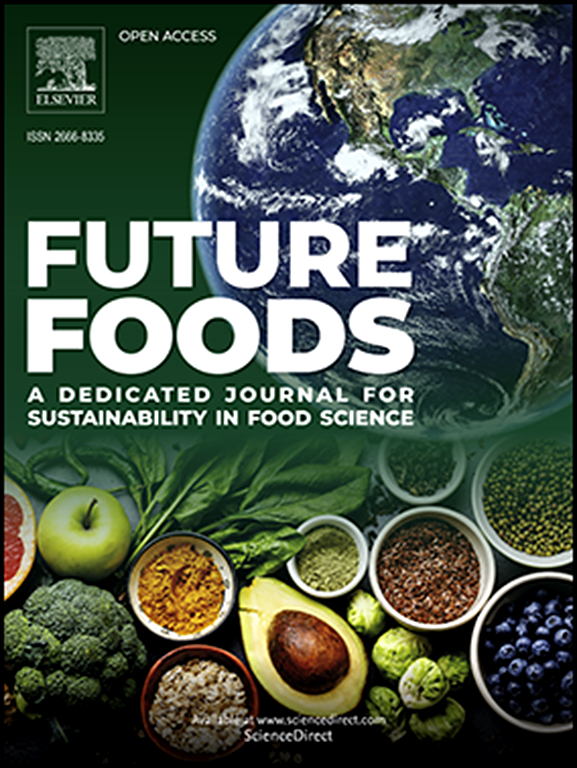Fatty acid composition and lipid stability of cricket (Gryllus bimaculatus) flour preserved using ginger and garlic extracts
IF 7.2
Q1 FOOD SCIENCE & TECHNOLOGY
引用次数: 0
Abstract
Insect consumption is regarded as a sustainable diet with a high nutritional value and low environmental footprint. This study evaluated the fatty acid composition and oxidative stability of flour produced from crickets treated with ginger and garlic extracts. Ethanolic extracts of ginger, garlic and a combination were used to treat blanched cricket at a ration 1:4 (v/w). Treatments with sodium benzoate and distilled water served as positive and negative controls, respectively. Samples were dried in a hot air oven, milled to flour and packed in 10 µm polyethylene bags; stored at ambient conditions and evaluated on day on days 0, 30, and 60 of storage. Results showed that the major fatty acids in the flour were palmitic, oleic, and linoleic. During storage: palmitic acid increased from a range of 24.62 to 25.40 %; Oleic and linoleic acid decreased significantly ranging from 29.75 to 29.01 % and 32.85 to 32.21 %, respectively (p˂0.05). The ratio of polyunsaturated fatty acid to saturated fatty acid decreased significantly during storage. The acid value, peroxide value, and thiobarbituric acid reactive substances of flour increased significantly during storage (p˂0.05). The untreated flour was most affected than the spice treated flour. Treatment with a combination of ginger and garlic extracts is recommended due to the synergistic effect on the oil quality. Further investigation is required on the effects of various storage conditions and lengthy storage of spice preserved cricket flour on the fatty acid profile.

生姜和大蒜提取物保鲜蟋蟀粉的脂肪酸组成和脂质稳定性
食用昆虫被认为是一种具有高营养价值和低环境足迹的可持续饮食。本研究评价了生姜和大蒜提取物处理的蟋蟀面粉的脂肪酸组成和氧化稳定性。采用生姜、大蒜及组合乙醇提取物,按1:4 (v/w)的比例处理焯水蟋蟀。苯甲酸钠处理和蒸馏水处理分别作为阳性对照和阴性对照。样品在热风炉中干燥,磨成面粉,装在10µm聚乙烯袋中;储存在环境条件下,并在第0、30和60天进行评估。结果表明,面粉中的主要脂肪酸为棕榈酸、油酸和亚油酸。贮存期间,棕榈酸从24.62%增加到25.40%;油酸和亚油酸显著下降,分别为29.75% ~ 29.01%和32.85% ~ 32.21% (p小于0.05)。多不饱和脂肪酸与饱和脂肪酸的比值在贮藏过程中显著降低。面粉的酸值、过氧化值和硫代巴比妥酸活性物质在贮存期间显著增加(p小于0.05)。未经处理的面粉比香料处理的面粉受影响最大。由于对油脂质量的协同作用,建议使用生姜和大蒜提取物的组合治疗。不同贮藏条件和长时间贮藏对调味蟋蟀粉脂肪酸谱的影响有待进一步研究。
本文章由计算机程序翻译,如有差异,请以英文原文为准。
求助全文
约1分钟内获得全文
求助全文
来源期刊

Future Foods
Agricultural and Biological Sciences-Food Science
CiteScore
8.60
自引率
0.00%
发文量
97
审稿时长
15 weeks
期刊介绍:
Future Foods is a specialized journal that is dedicated to tackling the challenges posed by climate change and the need for sustainability in the realm of food production. The journal recognizes the imperative to transform current food manufacturing and consumption practices to meet the dietary needs of a burgeoning global population while simultaneously curbing environmental degradation.
The mission of Future Foods is to disseminate research that aligns with the goal of fostering the development of innovative technologies and alternative food sources to establish more sustainable food systems. The journal is committed to publishing high-quality, peer-reviewed articles that contribute to the advancement of sustainable food practices.
Abstracting and indexing:
Scopus
Directory of Open Access Journals (DOAJ)
Emerging Sources Citation Index (ESCI)
SCImago Journal Rank (SJR)
SNIP
 求助内容:
求助内容: 应助结果提醒方式:
应助结果提醒方式:


